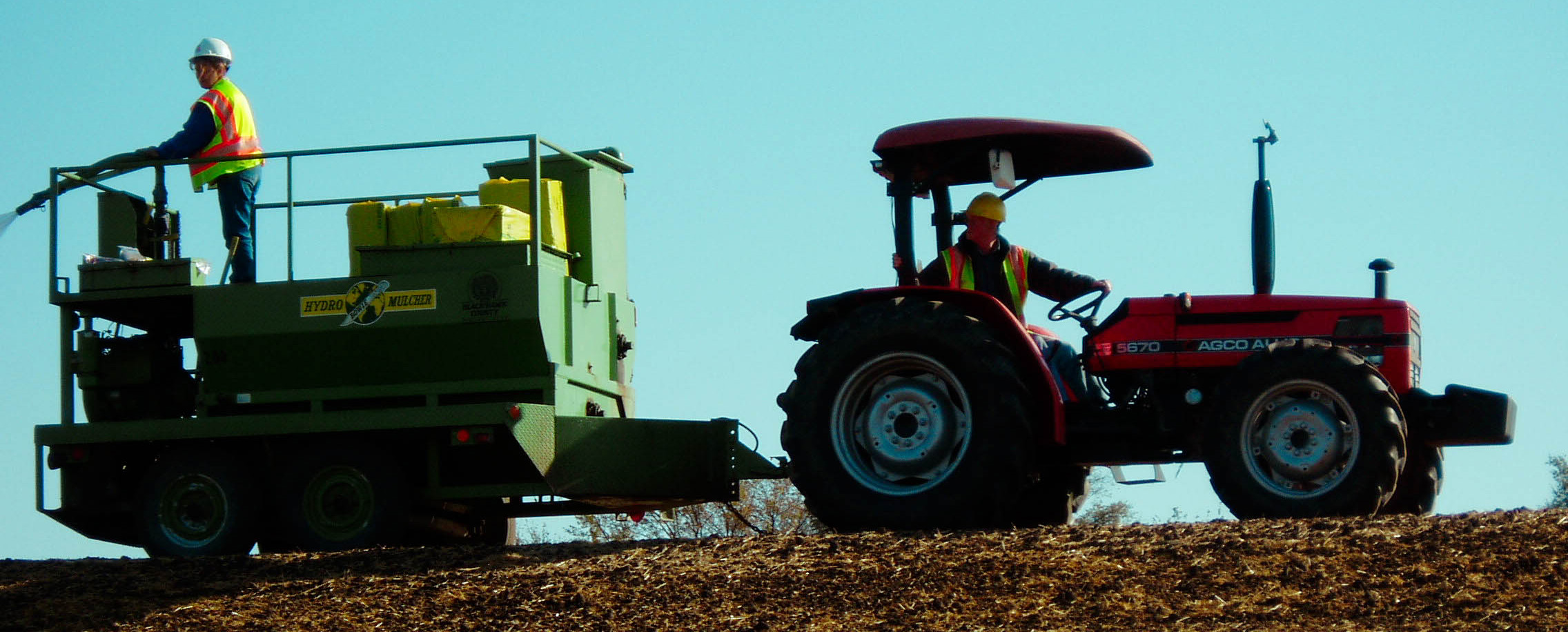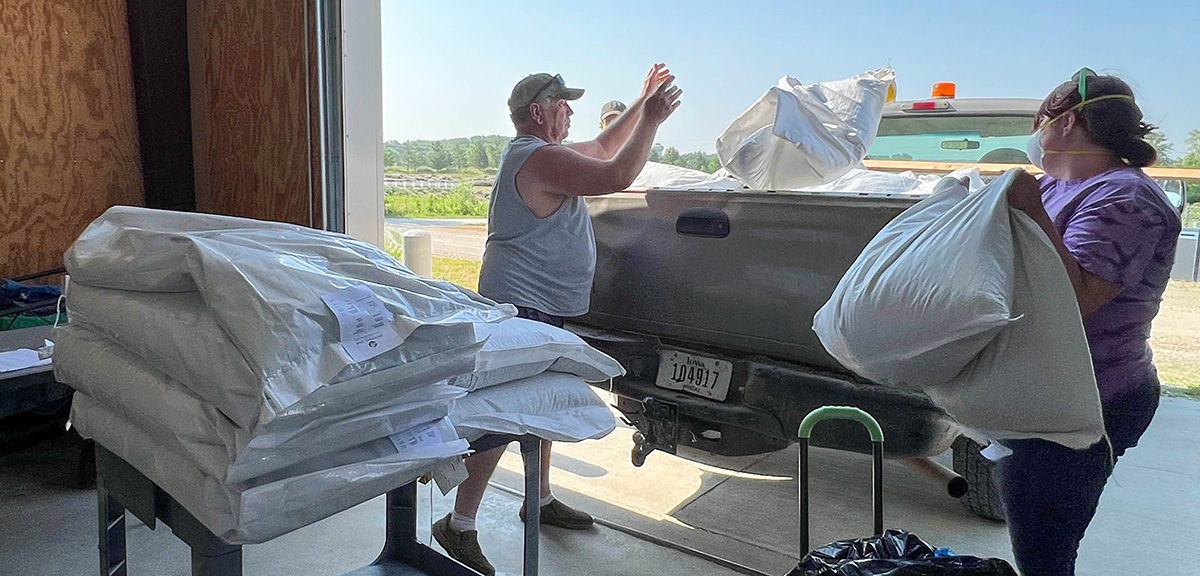Purchase program supplies and equipment
Table of Contents

Taking advantage of the Living Roadway Trust Fund
Since 1990, counties have enjoyed support from the Iowa Department of Transportation’s Living Roadway Trust Fund (LRTF). Roadside managers submit applications each year to acquire resources for their program. The LRTF does not fund salaries, trucks, or tractors. While eligibility for this funding requires only that a county have an Integrated Roadside Vegetation Management (IRVM) plan on file with the LRTF, a county’s level of commitment to IRVM is a factor when grants are awarded. Having a full-time roadside manager demonstrates a strong commitment. Applications are due June 1 each year.
Typical equipment needed for a program
LRTF grants can be used to cover 80–100% of the cost of most of these items. See the latest LRTF Funding Guidelines or contact the LRTF coordinator to verify if LRTF funds can be used for a particular purchase.
heavy duty pickup truck (¾ ton or large enough for a fire pumper unit)
- 60 horsepower tractor with dual rear axle
- flatbed truck for use as a herbicide spraying rig
- Many counties are using flatbed truck mounted spray units with chemical injection, spray heads and GPS. LRTF will fund up to 80% of the cost.
- Sprayers are not a high priority for LRTF, so the more of the cost the county or city can cover, the better its chances of approval. The total cost can easily be $25,000.
- truck or trailer for hydroseeding
- broadcast seeder
- hydroseeder (minimum 800 gallons with mechanical agitation)
- six-foot native seed drill
- cultipacker
- boom mower
- chainsaws
 brush chipper
brush chipper- GPS
- utility vehicle
- fire rigs and safety equipment
- straw mulch blowers
- harrows and drags
- trailers
- silt fence equipment
- equipment shed
- storage room
- herbicide storage equipment
- brush mowers
- broadcast seeder
Roadside vegetation inventories
The most effective roadside management starts with an accurate picture of the condition of roadsides in the county or city. A roadside vegetation inventory helps decision makers set management priorities and provides baseline data for measuring program success.
Information collected in a roadside vegetation inventory includes herbaceous cover, tree and brush cover, weed concerns, bare areas, and areas with erosion and encroachment. The inventory development process typically involves a windshield survey, which means observing the roadside conditions while driving throughout the county or city. Windshield survey observations can be recorded every quarter mile or whatever interval is needed. Those conducting the inventory must be able to identify weeds, distinguish native prairie vegetation from non-native grasses, and recognize areas of erosion and encroachment. If more than one individual is conducting the inventory in separate vehicles, training must be provided to ensure accurate, uniform data collection.
LRTF funds can be used to hire someone to do the inventory. The roadside manager and county engineer make the plan for the inventory process and train the person who does the inventory so the collected data will be accurate and useful. Allow six to eight weeks to complete the inventory. It is ideal to conduct the inventory in late summer or fall since this is the easiest time to identify stands of native vegetation.
If paid for by LRTF grant funding, rules stipulate that roadside inventories must be recorded on GPS devices. The LRTF provides free software for collecting and recording roadside inventory information. The LRTF also funds the purchase of GPS units, mapping software and laptop computers.
People who may be hired to conduct a roadside vegetation inventory include:
- faculty and students from a nearby college who are familiar with conducting plant surveys;
- Leland Searles, consultant and photographer, Leeward Solutions, searleslr@msn.com, 515-979-6457; or
- Mike Heller, lead environmental scientist, Foth Infrastructure and Environment, mike.heller@foth.com, 515-251-2572.
Identify prairie remnants
Every county in the state has a few roadsides containing small patches of native plants descended from the original prairie. These prairie remnants may possess just a few species or they may be quite diverse. Either way, they provide a glimpse into the past and are valued as sources of genetic material and models for future prairie restoration. They merit protection.
Look for prairie remnants in places like an old railroad right-of-way that parallels the highway or land that may have been too rocky or wet to till. A thorough survey of roadsides in your jurisdiction is the best way to document the location of remnants and prevent their destruction. Generally, do not try to enhance a remnant by inter-seeding with native seed unless that seed comes from remnants in the immediate vicinity.
Native seed from the Iowa Roadside Management Office

Since 1998, nearly all native seed planted in Iowa rights-of-way has been provided to counties and cities at no cost to them. The seed has been paid for with Federal Highway Administration (FHWA) grant funding secured by the Iowa Roadside Management Office at the Tallgrass Prairie Center. The FHWA program providing the grant funding has undergone several name changes over the years and is currently the Transportation Alternatives Set-Aside Program. These funds are approved annually.
Prior to requesting free seed, counties and cities must file an approved IRVM plan with the LRTF and provide the labor and equipment to plant the seed. These native seed mixes have a value of $250–350 per acre and can only be used in road rights-of-way. For example, the seed cannot be used along trails that are outside of road rights-of-way.
Each September or October, the TPC roadside program manager emails eligible counties and cities to solicit seed requests for the subsequent year. Roadside managers will need to decide how many acres they would like to receive and provide maps showing where seed will be drilled or planted using heavy equipment that may cause rutting of the soil greater than 6 inches. The Iowa DOT archaeologist will review this information to ensure no Indigenous burial sites will be impacted. Maps do not need to be provided for sites that will be hydroseeded or broadcast seeded since these methods cause only shallow soil disturbance that will not affect burial mounds.
The seed is typically distributed over a two-day period in April, May, or June at the shed south of the Tallgrass Prairie Center. The seed must be planted by December 31 of the following year. The FHWA requires recipients to provide a seed report with maps every six months showing where the seed was planted.
A few counties have created their own seed production plots to supplement the seed they obtain from the Iowa Roadside Management Office. Counties also occasionally purchase seed from commercial sources to supplement what they receive from the Iowa Roadside Management Office.
Create data collection tools and processes needed to evaluate the program
GIS mapping tools can be used to record data on roadside management activities such as brush cutting, spraying, and invasive species removal.

